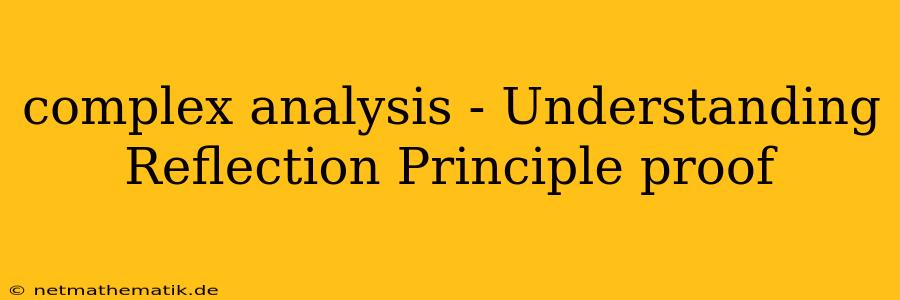The Reflection Principle in complex analysis is a powerful theorem that establishes a relationship between analytic functions and their behavior across a boundary. It states that if a function is analytic in a domain that includes a portion of the real axis, and its values on the real axis are real, then the function can be analytically extended to a larger domain by reflecting across the real axis. This principle finds applications in various areas of mathematics, including physics, engineering, and computer science. This article will delve into the Reflection Principle and provide a comprehensive understanding of its proof, highlighting key concepts and nuances.
The Reflection Principle: A Foundation for Understanding Analytic Function Behavior
The Reflection Principle is a cornerstone theorem in complex analysis, offering a profound insight into the behavior of analytic functions. It states that an analytic function in a domain that includes a portion of the real axis, with real values on that portion, can be extended analytically across the real axis to a larger domain. This principle is instrumental in understanding the symmetry and regularity of analytic functions and has numerous applications in various mathematical disciplines.
Statement of the Theorem
The Reflection Principle can be formally stated as follows:
Let f(z) be an analytic function defined on a domain D that includes a portion of the real axis. If f(z) is real-valued for all z on the real axis within D, then f(z) can be analytically extended to the domain D' that is the reflection of D across the real axis. The extended function is given by:
f*(z) = conj(f(conj(z)))
where conj(z) denotes the complex conjugate of z.
Proof of the Reflection Principle
The proof of the Reflection Principle relies on the Cauchy-Riemann equations and the fact that the complex conjugate of an analytic function is also analytic. The following steps outline the proof:
-
Cauchy-Riemann Equations: Let f(z) = u(x, y) + iv(x, y) be an analytic function in D, where u and v are real-valued functions of x and y. The Cauchy-Riemann equations are:
∂u/∂x = ∂v/∂y and ∂u/∂y = -∂v/∂xThese equations hold for all z in D.
-
Real Values on the Real Axis: Since f(z) is real-valued on the real axis, we have v(x, 0) = 0 for all x in D.
-
Complex Conjugate of f(z): Let's consider the complex conjugate of f(z), denoted by conj(f(z)):
conj(f(z)) = conj(u(x, y) + iv(x, y)) = u(x, y) - iv(x, y) -
Cauchy-Riemann Equations for conj(f(z)): Since conj(f(z)) is the complex conjugate of f(z), it also satisfies the Cauchy-Riemann equations:
∂u/∂x = -∂v/∂y and ∂u/∂y = ∂v/∂x -
Extension Across the Real Axis: Now, consider the function f*(z) = conj(f(conj(z))). This function is defined in the domain D' that is the reflection of D across the real axis. We can express f*(z) as follows:
f*(z) = conj(f(conj(z))) = conj(f(x - iy)) = conj(u(x, -y) + iv(x, -y)) = u(x, -y) - iv(x, -y)Since u and v are real-valued functions, we can see that f*(z) is also analytic in D'.
-
Continuity and Differentiability: It can be shown that f*(z) is continuous and differentiable at the boundary of D and D' (the real axis), making it a smooth extension of f(z).
-
Uniqueness of the Extension: This extension f*(z) is unique. Any other analytic extension of f(z) to D' must coincide with f*(z) due to the uniqueness of analytic continuations.
Therefore, the Reflection Principle is proven. It shows that an analytic function with real values on a segment of the real axis can be analytically extended across the real axis by reflecting the function across the axis. This principle allows us to study and understand the behavior of analytic functions in more complex domains.
Applications of the Reflection Principle
The Reflection Principle has wide-ranging applications in various mathematical disciplines:
-
Solving Boundary Value Problems: The Reflection Principle is fundamental in solving boundary value problems in physics and engineering, particularly in electrostatics and fluid dynamics. It allows us to find solutions to problems involving a boundary that coincides with a segment of the real axis.
-
Conformal Mapping: Conformal mappings are transformations that preserve angles. The Reflection Principle plays a role in constructing conformal mappings by extending analytic functions across boundaries. It allows for the mapping of regions with complex geometries to simpler regions.
-
Harmonic Functions: Harmonic functions are solutions to Laplace's equation, which arises in numerous physical phenomena. The Reflection Principle aids in finding solutions to boundary value problems involving harmonic functions by extending them across boundaries.
-
Number Theory: The Reflection Principle finds applications in number theory, particularly in the study of the Riemann zeta function. This function has a connection to the distribution of prime numbers, and the Reflection Principle helps understand its behavior across the critical line.
-
Complex Analysis: The Reflection Principle is a fundamental tool in the development of complex analysis. It helps establish crucial properties of analytic functions and allows for their extension to larger domains, facilitating further study and application.
Conclusion
The Reflection Principle is a powerful theorem in complex analysis that highlights the connection between analytic functions and their behavior across boundaries. It allows us to extend analytic functions across the real axis, enabling the exploration of their properties in larger domains. This principle has far-reaching applications in various fields, including physics, engineering, and number theory. Its understanding is crucial for comprehending the structure and behavior of analytic functions and their role in solving diverse problems.
